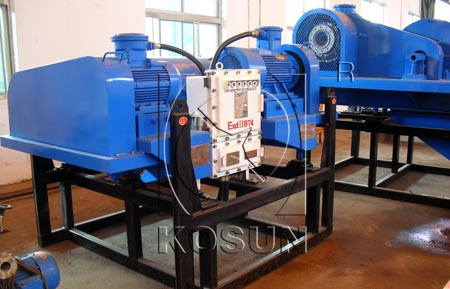Mar 03, 2014
Economic justification for using decanter centrifuges with weighted muds traditionally has been based on the savings realized by recycling the larger barite particles. However, this is not the most important benefit. When centrifuges are not used, the concentration of fines tends to be higher and the mud quality lower. This often leads to an increase in costly hole problems, which can be a much larger economic factor than the savings from the "barite recovery" process. In fact, the finer barite particles are discarded with the overflow, and this can be a significant part of the total barite present. Using the "quick and dirty" barite recovery concept to justify centrifuge rental is a simple, though flawed calculation that has impeded the understanding of the real benefits of using centrifuges with drilling fluids.
Much current drilling centrifuge application with drilling fluids is not only unproductive, but is counterproductive. One example of misuse is the practice of running two centrifuges in parallel to "recover the barite" with the first and "discard the drilled solids" with the second. The first stage is traditional centrifuging, returning the underflow to the active mud system. Rather than discarding the overflow, it is routed to the second centrifuge running at a higher speed, where the low-gravity solids supposedly are discarded and the "clean" liquid is returned to the mud.
Modern Application of Decanter Centrifuge
This process cannot, does not, and will not work! It is based on two erroneous assumptions:
1. the first centrifuge is capable of separating barite from low gravity solids;
2. the second centrifuge is capable of producing a solids-free liquid for return to the mud.

Both of these assumptions are incorrect and ignore the physics of sedimentation. Further, the process assumes that the objective of centrifuging weighted fluids is the removal of low-gravity solids. It is not. The objective is the removal of the colloidal and near-colloidal solids that are so detrimental to drilling fluids performance; their specific gravity is barely relevant. Centrifugation is accelerated sedimentation using increased gravitational forces and is described by Stokes' Law. It states that the sedimentation rate is directly proportional to the difference in density between the settling particle and the surrounding liquid, and inversely proportional to the viscosity of the liquid. It is a mathematical means of expressing what we intuitively know to be true: heavier particles settle quicker in lighter, less viscous liquids.
Used drilling muds weighted with barite contain both barite and drilled solids ranging from less than 1μm to more than 20μm. Assuming that the average specific gravity of barite and low-gravity solids particles are 4.2 and 2.6 respectively, the mass of a barite particle is equal to that of a LGS particle about 50% larger. For example, if most of the barite particles finer than 6µm remain in the overflow, then most of the low-gravity solids particles finer than 9µm will also remain in the overflow. The larger particles - both barite and drilled solids - will be found in the underflow. Thus, we don't separate barite from low-gravity solids; we separate heavier (larger) particles from lighter (smaller) ones.
Let's consider what happens in the series drilling decanter centrifuging process. Assuming that the "barite recovery" unit makes an 8μm cut on barite, and that the second unit makes a 4μm cut, most of the barite larger than 8µm and the low-gravity solids larger than 12µm are returned to the mud at the first stage. At the second stage, the remaining barite larger than 4µm and the low-gravity solids larger than 6µm are discarded, and the finest - most damaging - material is returned to the mud!
No matter what the two cut points are, the material that is removed falls between them. This fraction includes barite in a perfectly acceptable size range and low-gravity solids that are too large to increase viscosity, and too fine to be very abrasive. All of the finest solids, both barite and cuttings, are returned to the mud system, assuring a progressive decrease in average particle size and decline in mud quality. The decreasing particle size increases the viscosity and the need for dilution, while diminishing wall cake quality and promoting the deterioration of hole conditions.
Worse yet, the desirably sized barite that is discarded must be replaced by fresh barite, 30% of which can be particles finer than 6µm, and 10%-15% of which can be expected to be colloidal (< 2µm). This further reduces average particle size and accelerates the decline of mud quality.
The two-stage centrifugation process is expensive and harmful. By increasing the need for dilution, it increases mud cost and drilling waste volume. Even worse, it actually reduces mud quality. This industry wastes millions of dollars each year running centrifuges in parallel in the belief that we are "recovering the barite at the first stage, and discarding the drilled solids at the second.
KOSUN, as a professional oilfield solids control system and decanter centrifuge manufacturer in China, obtains much experience in designing & manufacturing all these drilling mud recycling system, such as shale shaker, desander, desilter, mud cleaner, centrifuge, mud agitator, mud gun, jet mud mixer, etc. and have exported to many countries & obtain good reputation with qualified products & superior service.